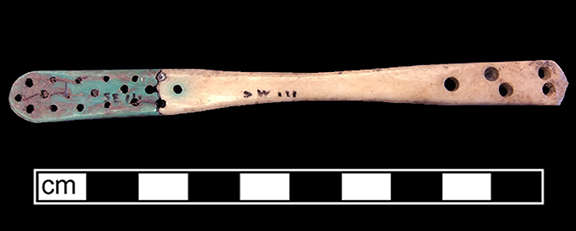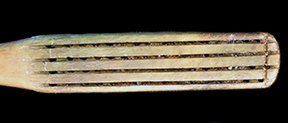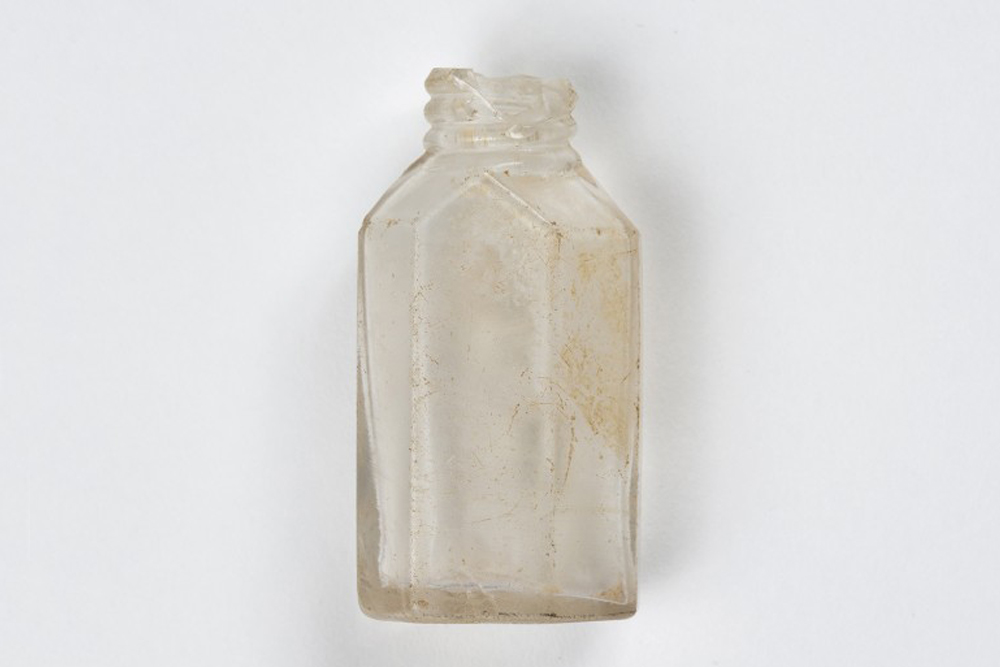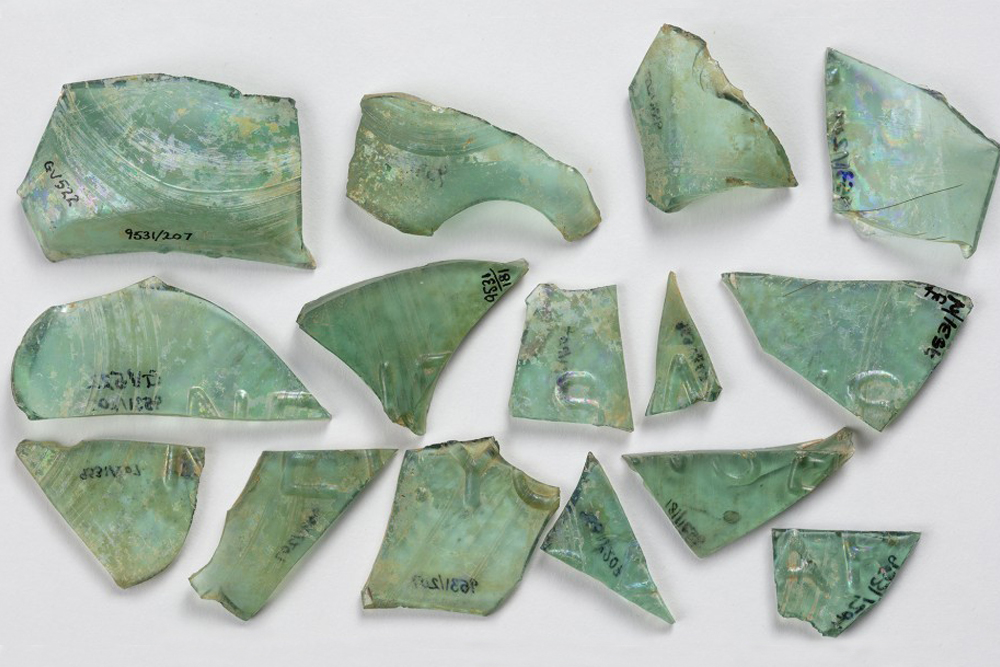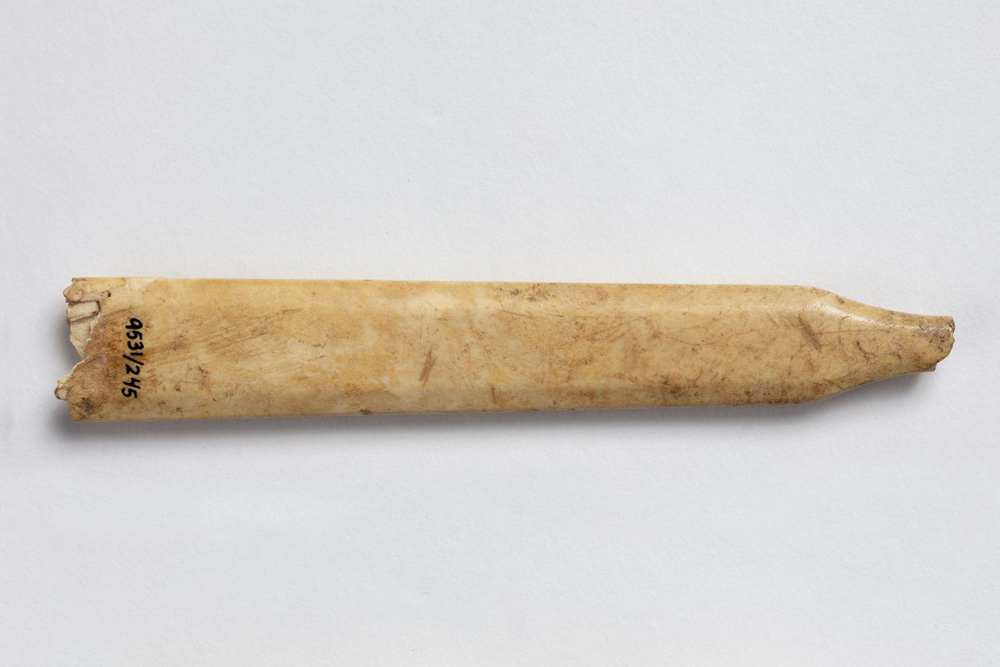Toothbrush handle
Today we take good oral hygiene for granted, but this is only a recent phenomenon in human history. This is due to factors like the discovery that fluoride prevents tooth decay and antibiotics can cure abscesses, not to mention improved nutrition, maternal and infant health, dental surgery techniques, braces, retainers, implants, etc. Having good teeth during the 19th-century, when not many people had toothbrushes, was a very big accomplishment and may have even motivated others to have good hygiene.

Figure 1. Toothbrush handle (Photo courtesy of the NYC Archaeological Repository).
The History of the Toothbrush
According to archaeologist Patricia Samford, it has been estimated that only one in four people in the U.S. owned a toothbrush in the 1920s (Samford 2014). Humans have probably cleaned their teeth for thousands of years using various materials like cloth, sponges, chew sticks, and, in this case, bone. The first toothbrush was made in China at the end of the fifteenth century, but was still not used widely at that time. Toothbrushes became more widespread during the eighteenth and nineteenth centuries and were typically made of bone. They were of different sizes and shapes, with some looking like paintbrushes and others being double-sided.
Main Components of Toothbrushes
Toothbrushes can be divided into three main components, according to archaeologist Barbara Mattick (Mattick 1993, 165 ). These three components are useful when it comes to determining its manufacturer and assigning a specific date and location. The three main compartments are the handle, the neck, and the head. The head is the part that contains the bristles and stocks, which were made in three specific shapes. A way to determine the specific date of manufacture is by looking at the brush head and neck and its relationship to the handle. If the head and neck are set to an angle to the handle, the toothbrush is considered “cranked.” When the head is angled away from the face when the brush is held horizontally, it is known as convex cranking. This was the style of toothbrush that was most frequently used up to 1884, but was rarely seen by the 1920s. Another thing one should look for is the appearance of bristle holes.
Dental Hygiene in Seneca Village
The toothbrush that is seen in Figure 1 belonged to the Wilson family in Seneca Village. Since not too many people owned toothbrushes at that time, it can be concluded that Wilson family was financially more advantaged than other residents of Seneca Village. They had the economic ability to invest in their health in order to maintain good hygiene for their teeth at a time when toothbrushes were still relatively new. According to the 1855 Census, the Wilsons had eight children, but even so were able to invest in their health.
Bone Toothbrush Composition
The most common material for toothbrushes was bone, although the wealthy had toothbrushes made of silver, gold, mother of pearl, or ivory. Bone was used because it withstood moisture better than wood and was strong, widely available, and inexpensive. The bones that were mostly used were femur bones from cattle–“[c]attle femurs were used to make toothbrushes because they were the only material strong enough to withstand the pressures of manufacturing and constant exposure to moisture” (Mattick 1993, 168). These femur bones were shaped into toothbrushes through bleaching or boiling in a weak solution of hydrogen peroxide. By 1874, the process of making toothbrushes became easier using machines.
The bristles of the toothbrushes were made of natural materials, primarily boar bristles, which were often imported from China, but this stopped in 1937 because of shortages during World War II. This is when many started using synthetic materials, primarily nylon. Toothbrushes prior to this time “were typically made of bone, bamboo, ivory with coarse boar hair bristles” (Samford 2014). The bristles of these toothbrushes are pulled into holes in order to form tufts, which was done through the use of wires or threads. During the 1780s, France and England were considered the world’s major manufacturers of toothbrushes. The toothbrushes that were available in America were likely imports, considered luxury items and owned mostly by the wealthy at that time (Mattick 1993, 166).
Works Cited
Mattick, Barbara E. 1993. “The History of Toothbrushes and their Nature as Archaeological Artifacts.” Florida Anthropologist 46, no. 3: 162-184.
New York State Census (NYSC). 1855. Census Returns for the Sixth Ward of the City of New York in the County of New York. Manuscript, Department of Records and Information, Municipal Archives of the City of New York, New York, NY.
New York City Archaeological Repository: The Nan A. Rothschild Research Center. 2020. “Seneca Village.” NYC Landmarks Preservation Commission, New York, NY. http://archaeology.cityofnewyork.us/collection/map/seneca-village.
Samford, Patricia. 2014. “Bone-Handled Toothbrushes.” Jefferson Patterson Park & Museum, State Museum of Archaeology. https://apps.jefpat.maryland.gov/diagnostic/SmallFinds/Toothbrushes/index-BoneHandledToothbrushes.html

